Spatiotemporal Evolution of Gas in Transmission Fluid under Acoustic Cavitation Conditions
Abstract
:1. Introduction
2. Methods
2.1. Conservative Homogeneous Flow Model
2.2. State Equation of Gas–Liquid Mixtures
2.3. Cavitation Types and Conditions
2.4. Numerical Solution Method
3. Results
3.1. Physical Properties of Transmission Fluid
3.2. Pressure Transmission Characteristics
3.3. Transient Change of Air and Vapor Void Fraction
4. Discussions
4.1. Spatiotemporal Evolution of Gas Void Fraction
4.2. Relationship of Fluid Temperature and Gas Void Fraction
4.3. Complexity and Limitations on Gas Spatiotemporal Evolution Modelling
5. Conclusions
- When the initial gas content is 1.425%, the maximum gas void fraction in the whole cavitation process reaches 1.925%. The gas void fraction increases with the decrease in pressure, and the peak value of pressure fluctuation is delayed.
- In the air cavitation zone, the lower the pressure is, the faster the air void fraction increases. The maximum air void fraction is about 1.425%. In the pseudo-cavitation zone, the gas void fraction decreases with the increase in pressure. In the vapor cavitation zone, cavitation mainly occurs within x = 0–0.51 m. The maximum vapor void fraction is about 0.5%, and the maximum cavitation duration is almost 0.04 s.
- Under the conditions given in this study, the fluid temperature change caused by the compression and expansion of transmission fluid is nearly 6 K.
Author Contributions
Funding
Institutional Review Board Statement
Informed Consent Statement
Data Availability Statement
Conflicts of Interest
References
- Xia, G.; You, W.; Manickam, S.; Yoon, J.Y.; Xuan, X.; Sun, X. Numerical simulation of cavitation-vortex interaction mechanism in an advanced rotational hydrodynamic cavitation reactor. Ultrason. Sonochem. 2024, 105, 106849. [Google Scholar] [CrossRef] [PubMed]
- Kan, Y.; Sun, D.; Luo, Y.; Ma, K.; Shi, J. Optimal design of power matching for wheel loader based on power reflux hydraulic transmission system. Mech. Mach. Theory 2019, 137, 67–82. [Google Scholar] [CrossRef]
- Cheng, W.; Shao, C.; Fan, H. Impacts of cavitation on flow field distributions and pump stability in cryogenic pumps. J. Low Temp. Phys. 2023, 211, 86–107. [Google Scholar] [CrossRef]
- Qiu, C.; Chen, S.; Yan, F.; Fu, Y.; Wei, W. Effect of temperature and pressure on cavitation characteristics in RP-3 jet fuel. Mod. Phys. Lett. B 2021, 35, 2150375. [Google Scholar] [CrossRef]
- Li, X.; Sun, J.; Xu, C.; Li, Y.; Zhang, R.; Qian, L.; Chen, Y. Visualization of bubble flow in the channel of a dimple-type embossing plate heat exchanger under different fluid inlet/outlet ports. Int. J. Heat Mass Transf. 2019, 145, 118750. [Google Scholar] [CrossRef]
- Motogna, M.S.; Moldovanu, D.; Mariasiu, F. Numerical analysis of fuel flow patterns at the nozzle exit considering different fuels and operating parameters of a Diesel engine. Trans. FAMENA 2018, 42, 63–74. [Google Scholar] [CrossRef]
- Wang, Q.; Li, X.; Xu, C.; Yan, T.; Li, Y. Bubble recognizing and tracking in a plate heat exchanger by using image processing and Convolutional Neural Network. Int. J. Multiph. Flow 2021, 138, 103593. [Google Scholar] [CrossRef]
- Folden, T.S.; Aschmoneit, F.J. A classification and review of cavitation models with an emphasis on physical aspects of cavitation. Phys. Fluids 2023, 35, 081301. [Google Scholar] [CrossRef]
- Aganin, A.A.; Mustafin, I.N. Cavitation bubble collapse and rebound in water: Influence of phase transitions. Int. J. Multiph. Flow 2022, 157, 104256. [Google Scholar] [CrossRef]
- Du, J.; Chen, F. Cavitation dynamics and flow aggressiveness in ultrasonic cavitation erosion. Int. J. Mech. Sci. 2021, 204, 106545. [Google Scholar] [CrossRef]
- Song, Y.; Hou, R.; Liu, Z.; Liu, J.; Zhang, W.; Zhang, L. Cavitation characteristics analysis of a novel rotor-radial groove hydrodynamic cavitation reactor. Ultrason. Sonochem. 2022, 86, 106028. [Google Scholar] [CrossRef] [PubMed]
- Zhang, S.; Qian, Z.; Ji, B. Estimation of cavitation erosion area in unsteady cavitating flows using a modified approach. Ocean Eng. 2022, 262, 112229. [Google Scholar] [CrossRef]
- Gao, D.; Yang, J.; Ge, L. Review of the cavitation mechanism and prevention or enhancement. Mod. Phys. Lett. B 2022, 36, 2150615. [Google Scholar] [CrossRef]
- Ralys, A.; Mokšin, V. Numerical simulation of a cavitating pulsating water jet used for removing contaminants from metal surfaces. Trans. FAMENA 2019, 43, 69–80. [Google Scholar] [CrossRef]
- Li, J.B.; Xu, W.L.; Zhai, Y.W.; Luo, J.; Wu, H.; Deng, J. Influence of multiple air bubbles on the collapse strength of a cavitation bubble. Exp. Therm. Fluid Sci. 2021, 123, 110328. [Google Scholar] [CrossRef]
- Xu, W.; Wang, Q.; Wei, W.; Luo, J.; Chen, S. Effects of air bubble quantity on the reduction of cavitation erosion. Wear 2021, 482, 203937. [Google Scholar] [CrossRef]
- Denner, F.; Schenke, S. Modeling acoustic emissions and shock formation of cavitation bubbles. Phys. Fluids 2023, 35, 012114. [Google Scholar] [CrossRef]
- Chaudhry, M.H.; Bhallamudi, S.M.; Martin, C.S.; Naghash, M. Analysis of transient pressures in bubbly, homogeneous, gas-liquid mixtures. J. Fluids Eng. 1990, 112, 225–231. [Google Scholar] [CrossRef]
- Li, J.; Carrica, P.M. Numerical study of the cavitating flow over backward facing step with a polydisperse two-phase flow model. Phys. Fluids 2023, 35, 063313. [Google Scholar]
- Sun, T.; Zong, Z.; Wei, Y.; Zhang, G. Modeling and computation of unsteady cavitating flows involved thermal effects using partially averaged Navier–Stokes method. Int. J. Comput. Methods 2023, 20, 1850095. [Google Scholar] [CrossRef]
- Li, L.; Cheng, X.; Zhu, Z.; Sun, X.; Zhang, X. Investigation of cavitation shedding mechanisms including reentrant jet and shock wave by Eulerian–Lagrangian multiscale simulation. Phys. Fluids 2024, 36, 032126. [Google Scholar] [CrossRef]
- Iben, U.; Munz, C.D.; Beck, M.; Wrona, F. Cavitation in hydraulic tools based on thermodynamic properties of liquid and gas. J. Fluids Eng. 2002, 124, 1011–1017. [Google Scholar] [CrossRef]
- Leon, A.S.; Ghidaoui, M.S.; Schmidt, A.R.; Garcia, M.H. A robust two-equation model for transient-mixed flows. J. Hydraul. Res. 2010, 48, 44–56. [Google Scholar] [CrossRef]
- Bousso, S.; Fuamba, M. Numerical simulation of unsteady friction in transient two-phase flow with Godunov method. J. Water Resour. Prot. 2013, 5, 1048–1058. [Google Scholar] [CrossRef]
- Catania, A.E.; Ferrari, A.; Manno, M.; Spessa, E. A comprehensive thermodynamic approach to acoustic cavitation simulation in high-pressure injection systems by a conservative homogeneous two-phase Barotropic flow model. J. Eng. Gas Turbines Power. 2006, 128, 434–445. [Google Scholar] [CrossRef]
- Catania, A.E.; Ferrari, A.; Manno, M. Development and application of a complete multijet common-rail injection-system mathematical model for hydrodynamic analysis and diagnostics. J. Eng. Gas Turbines Power. 2008, 130, 062809–062821. [Google Scholar] [CrossRef]
- Sun, W.; Tan, L. Cavitation-vortex-pressure fluctuation interaction in a centrifugal pump using bubble rotation modified cavitation model under partial load. J. Fluids Eng. 2020, 142, 051206. [Google Scholar] [CrossRef]
- Catania, A.E.; Dongiovanni, C.; Spessa, E. Delivery-valve effects on the performance of an automotive Diesel fuel-injection system. SAE Trans. 1999, 108, 1399–1415. [Google Scholar]
- Ferrari, A.; Manno, M.; Mittica, A. Cavitation analogy to gas dynamic shocks: Model conservativeness effects on the simulation of transient flows in high-pressure pipelines. J. Fluids Eng. 2008, 130, 031304. [Google Scholar] [CrossRef]
- Catania, A.E.; Ferrari, A.; Spessa, E. Temperature variations in the simulation of high-pressure injection-system transient flows under cavitation. Int. J. Heat Mass Transf. 2008, 51, 2090–2107. [Google Scholar] [CrossRef]
- Ferrari, A. Modelling approaches to acoustic cavitation in transmission pipelines. Int. J. Heat Mass Transf. 2010, 53, 4193–4203. [Google Scholar] [CrossRef]
- Ye, Y.; Liang, Y.; Dong, C.; Xu, Y.; Zhang, Z. Treating the phase change of cavitation as the source of vapor inside bubbles. Mod. Phys. Lett. B 2021, 35, 2150093. [Google Scholar] [CrossRef]
- ISO 4113-2010; Road Vehicles-Calibration Fluids for Diesel Injection Equipment. ISO: Geneva, Switzerland, 2010.
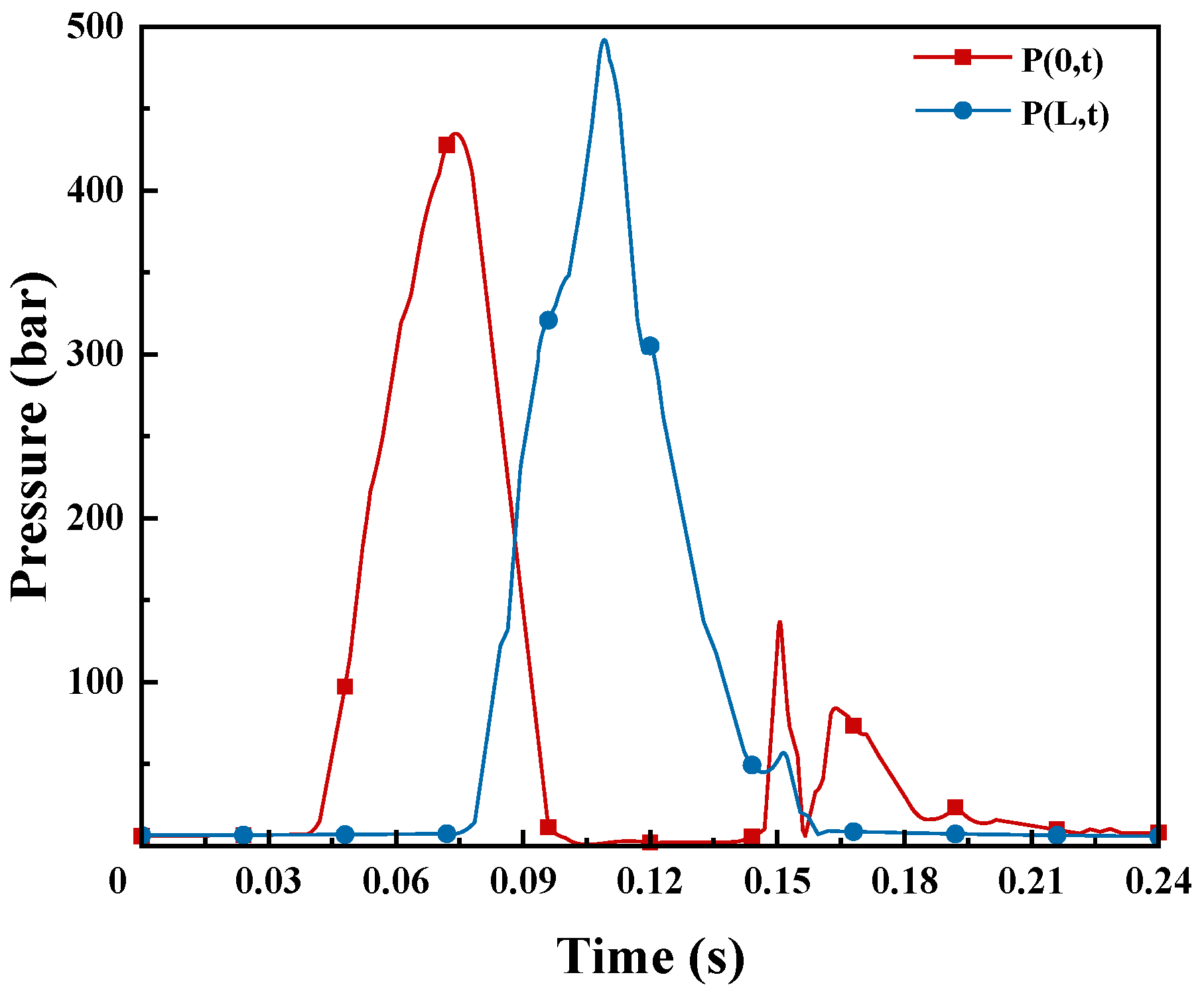
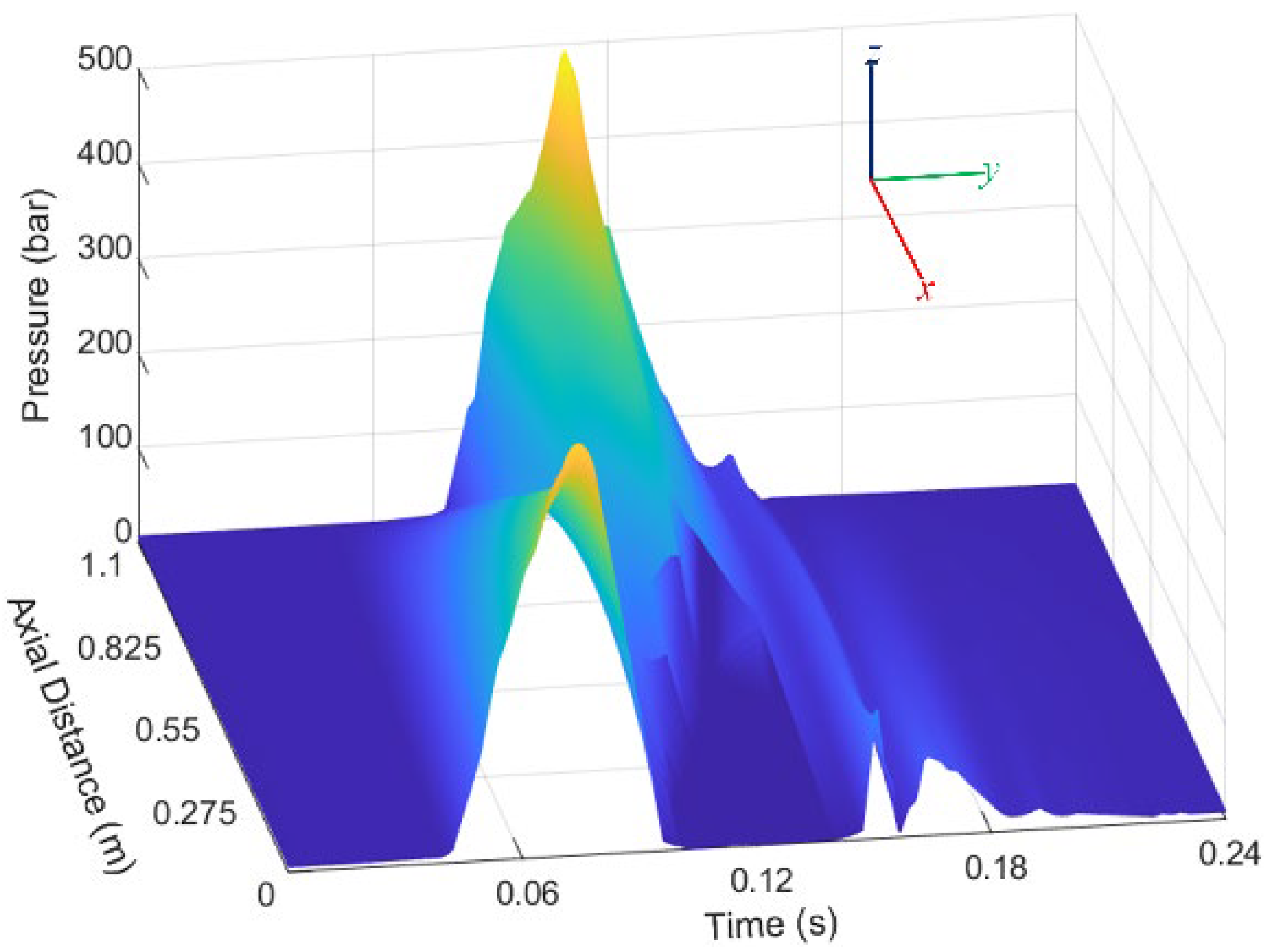
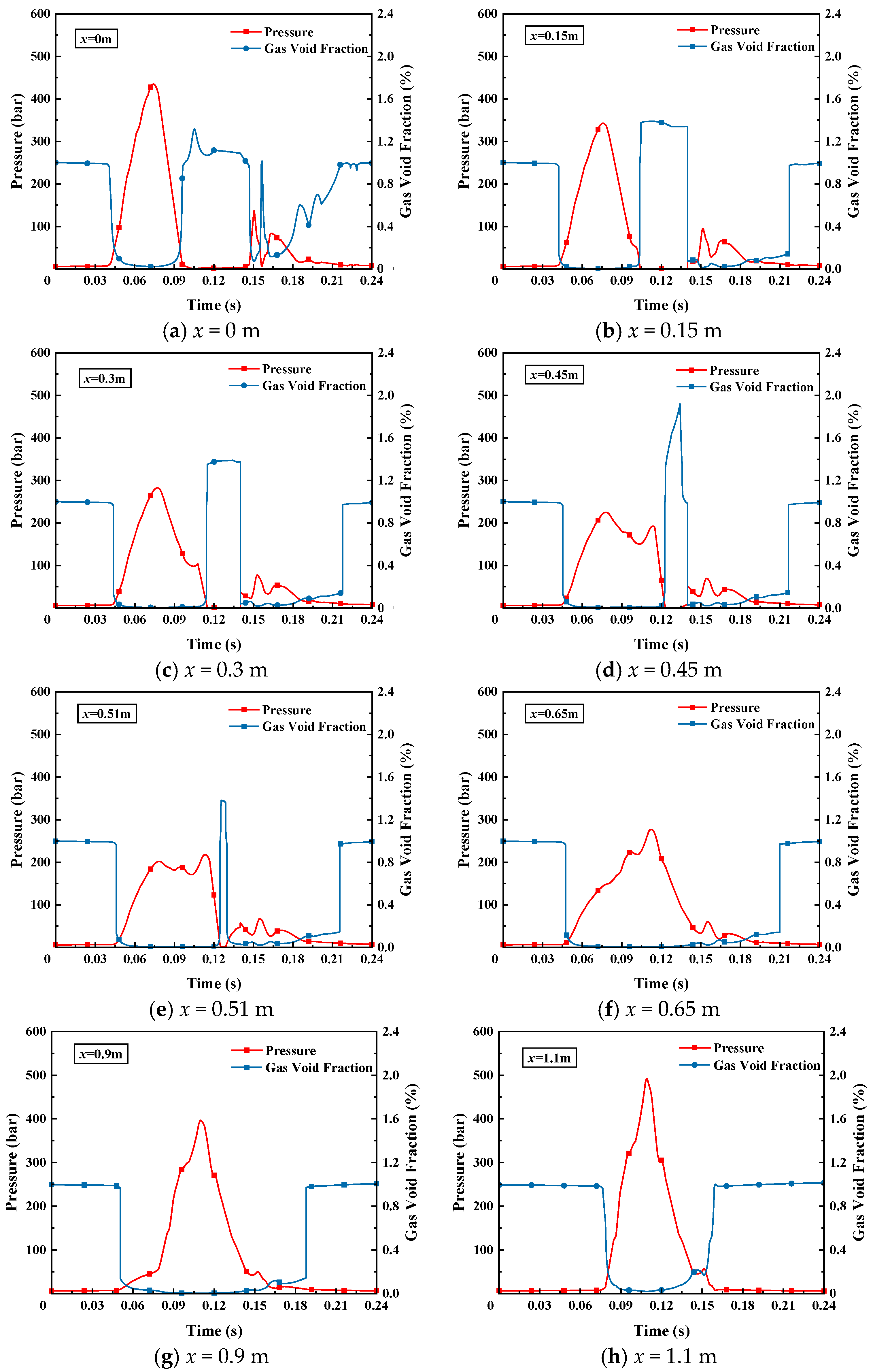
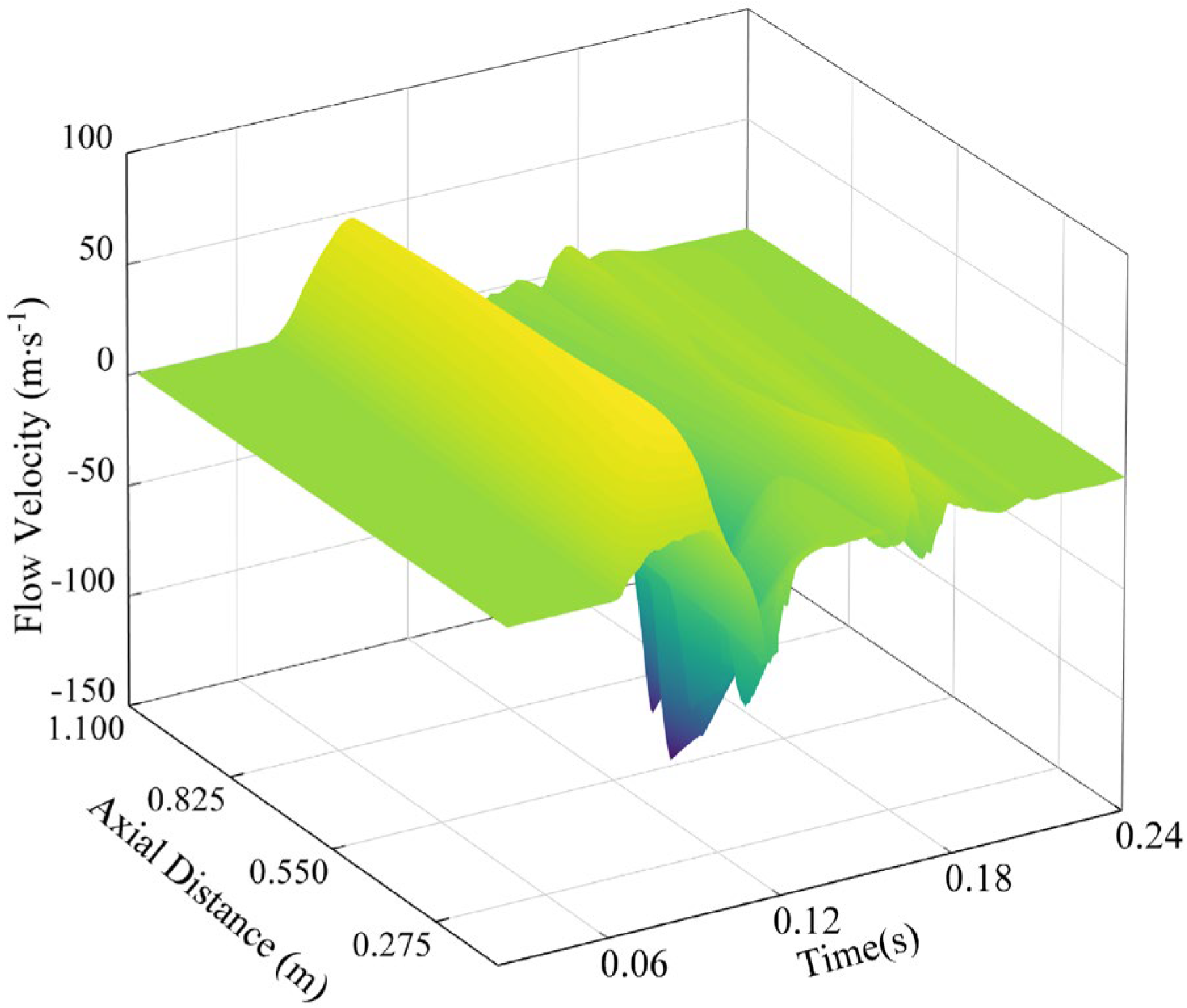
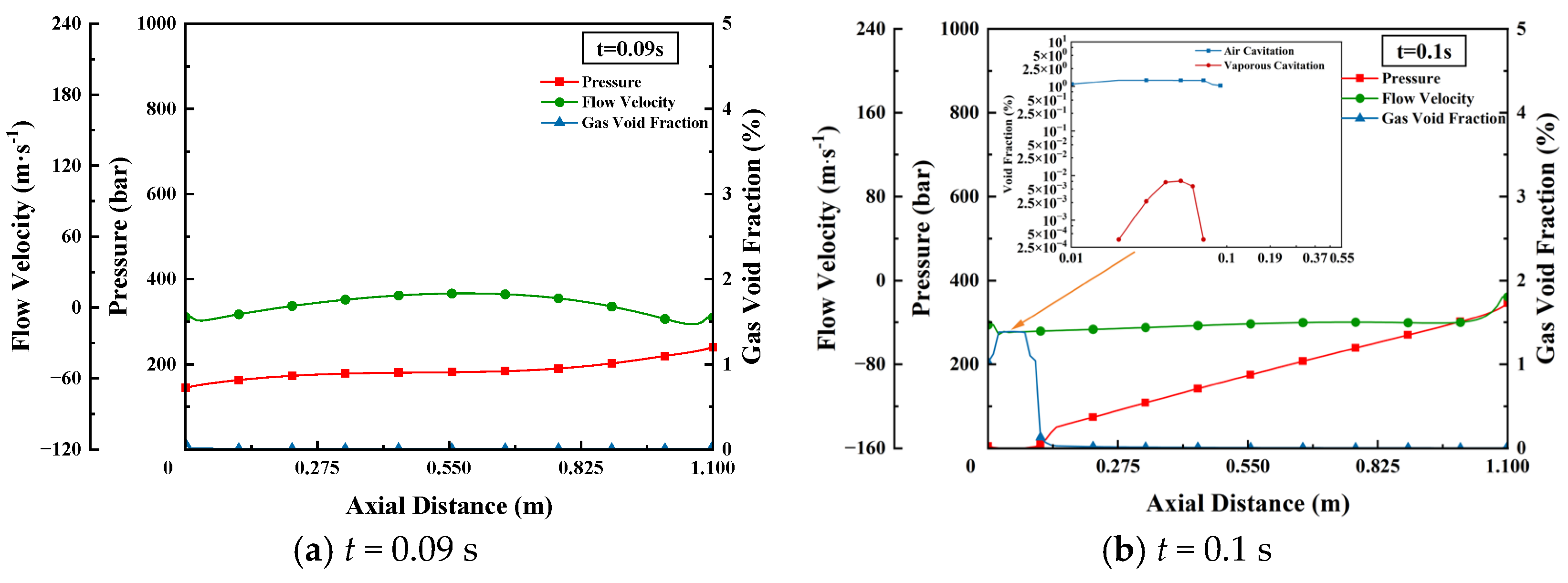
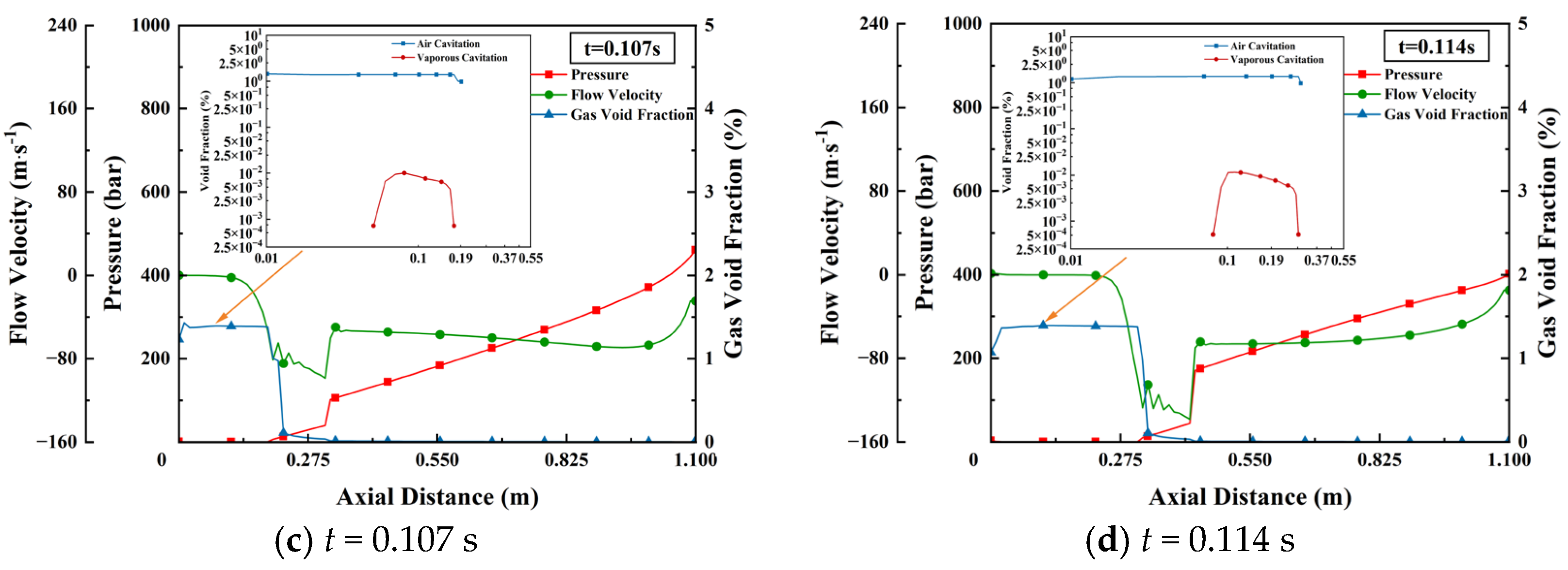

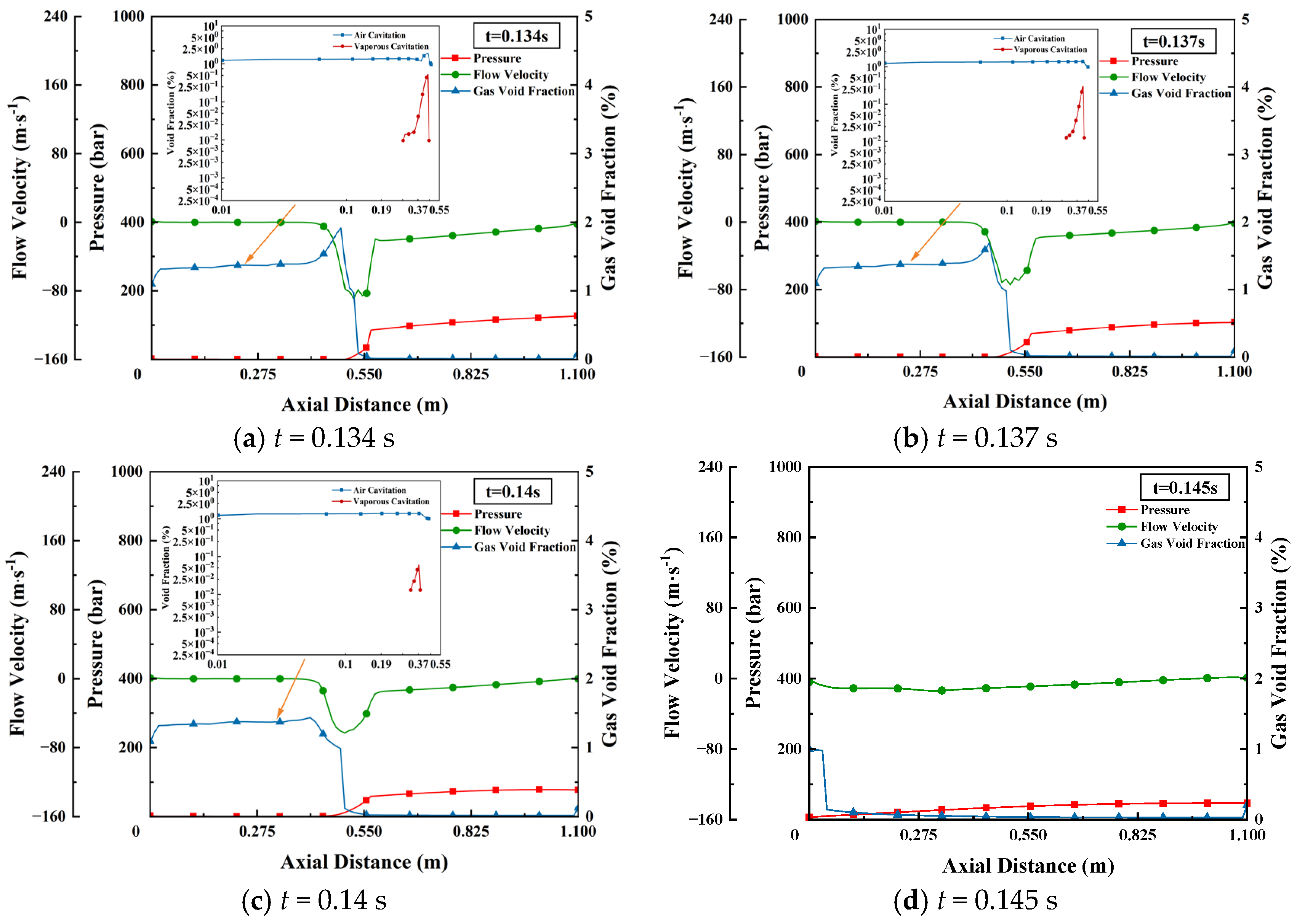

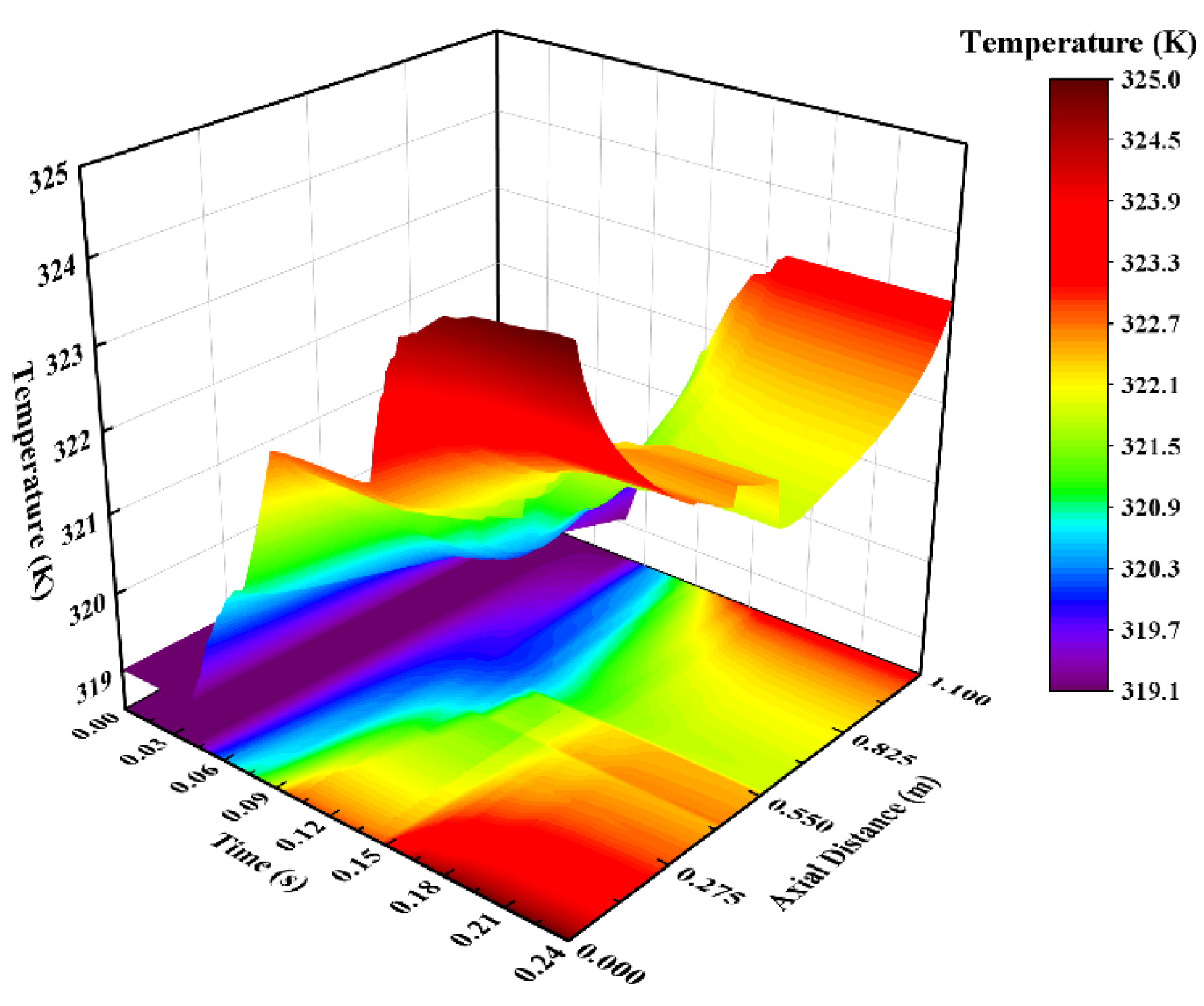
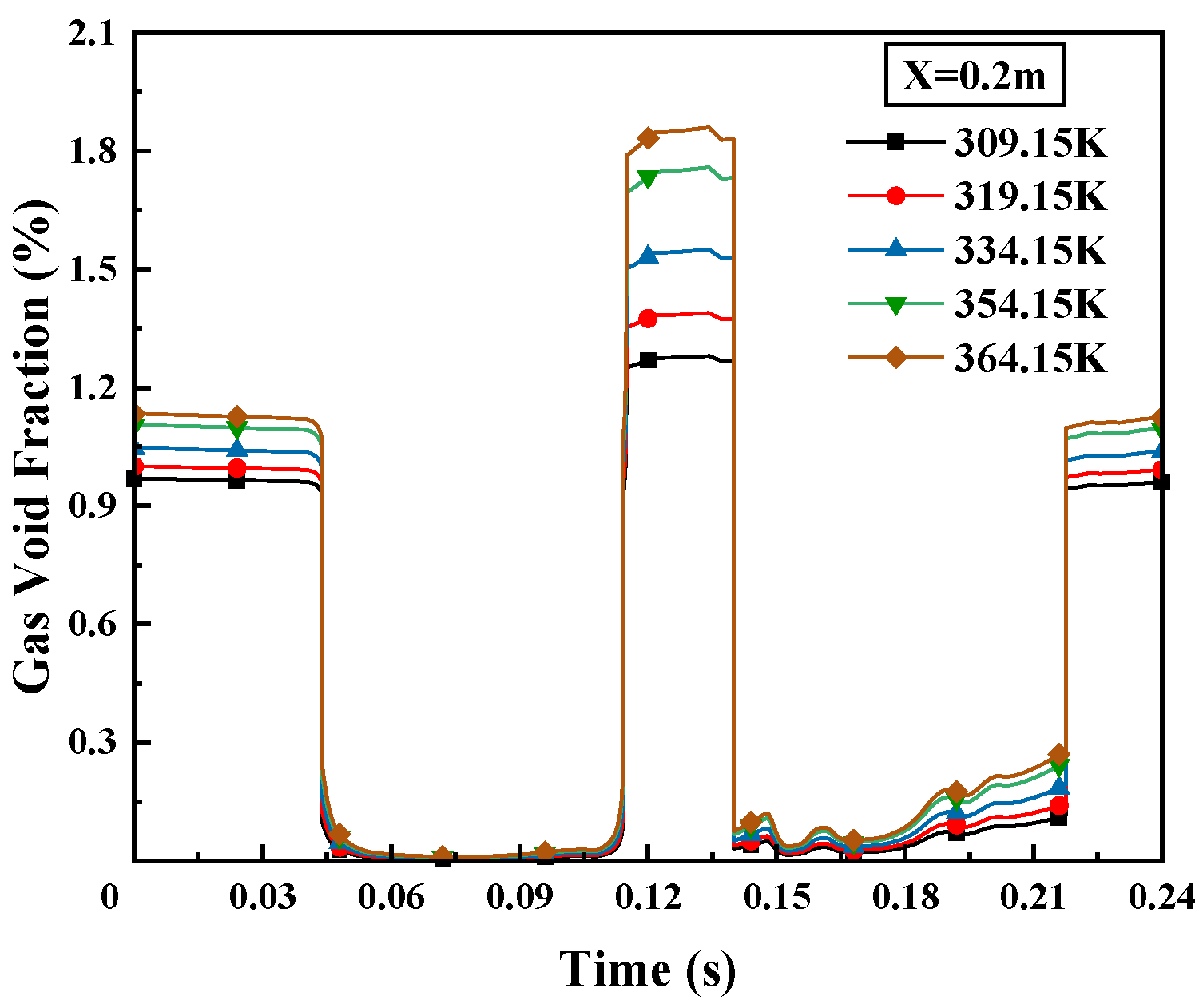
| Main Parameters | Unit | Value |
|---|---|---|
| Tube length | m | 1.1 |
| Tube diameter | mm | 2 |
| Air gas constant | J/(mol·K) | 287 |
| Vapor gas constant | J/(mol·K) | 87.34 |
| Atmospheric pressure | bar | 1 |
| Air separation pressure | bar | 10 |
| Saturated vapor pressure | bar | 0.65 |
| Specific heat capacity ratio | - | 1.2 |
| Initial gas-to-liquid mass flow rate ratio | % | 0.13 |
| Constant-pressure-specific heat capacity | J/(kg·K) | 2.06 |
Disclaimer/Publisher’s Note: The statements, opinions and data contained in all publications are solely those of the individual author(s) and contributor(s) and not of MDPI and/or the editor(s). MDPI and/or the editor(s) disclaim responsibility for any injury to people or property resulting from any ideas, methods, instructions or products referred to in the content. |
© 2024 by the authors. Licensee MDPI, Basel, Switzerland. This article is an open access article distributed under the terms and conditions of the Creative Commons Attribution (CC BY) license (https://creativecommons.org/licenses/by/4.0/).
Share and Cite
Wang, Y.; Chen, Y.; Li, X.; Xu, C.; Wei, W.; Zhao, J.; Jin, J.; Oppong, F. Spatiotemporal Evolution of Gas in Transmission Fluid under Acoustic Cavitation Conditions. Appl. Sci. 2024, 14, 6233. https://doi.org/10.3390/app14146233
Wang Y, Chen Y, Li X, Xu C, Wei W, Zhao J, Jin J, Oppong F. Spatiotemporal Evolution of Gas in Transmission Fluid under Acoustic Cavitation Conditions. Applied Sciences. 2024; 14(14):6233. https://doi.org/10.3390/app14146233
Chicago/Turabian StyleWang, Yongjin, Yihong Chen, Xiaolu Li, Cangsu Xu, Wenjian Wei, Jinhui Zhao, Jie Jin, and Francis Oppong. 2024. "Spatiotemporal Evolution of Gas in Transmission Fluid under Acoustic Cavitation Conditions" Applied Sciences 14, no. 14: 6233. https://doi.org/10.3390/app14146233
APA StyleWang, Y., Chen, Y., Li, X., Xu, C., Wei, W., Zhao, J., Jin, J., & Oppong, F. (2024). Spatiotemporal Evolution of Gas in Transmission Fluid under Acoustic Cavitation Conditions. Applied Sciences, 14(14), 6233. https://doi.org/10.3390/app14146233






